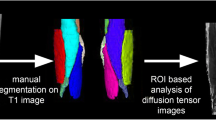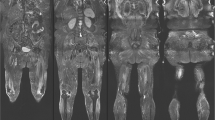Abstract
To investigate the performance of a biexponential signal decay model using DWI in myopathies and to differentiate Polymyositis (PM)/Dermatomyositis (DM), Glycogen Storage Diseases (GSDs) and Muscular Dystrophies (MDs) utilizing diffusion-weighted imaging. 11 healthy volunteers (control group) and 46 patients with myopathy were enrolled in the retrospective study. 27 of 46 patients had PM/DM, 7 patients GSDs and 12 patients MDs. After conventional MR sequences, diffusion weighted imaging with a b-factor ranging from 0 to 1200 s/mm2 was performed on both thighs. The intra-muscular signal-to-noise ratios (SNRs) on multiple-b DWI images were measured for 7 different muscles and compared among the different groups. The median T2 signal intensity and biexponential apparent diffusion coefficients (ADC), including standard ADC, fast ADC, and slow ADC values, were compared among the different groups. The intra-muscular SNRs were statistically significantly different depending on the b value, and also found among the 4 groups (p < 0.05). The median T2 signal intensity of the normal muscles in control group was statistically significantly lower than that of edematous muscles in the PM/DM, GSDs and MDs groups (p = 0.000), while there were no statistically significant differences among the PM/DM, GSDs, and MDs groups (p > 0.05). The median standard ADC value of the edematous muscles in GSDs was statistically significantly lower than that of normal muscles in the control group (p = 0.000) and the median ADC value of the edematous muscles in PM/DM patients was statistically significantly greater than that of the GSDs (p = 0.000) and MDs groups (p = 0.005). The median slow ADC value of the edematous muscles in MDs patients and PM/DM patients was statistically significantly greater than that of GSDs patients (p < 0.05). Intra-muscular SNR decay curves and biexponential ADC parameters are useful in distinguishing among PM/DM, GSDs, and MDs.




Similar content being viewed by others
References
Lovitt S, Moore SL, Marden FA (2006) The use of MRI in the evaluation of myopathy. Clin Neurophysiol 117(3):486–495
Dalakas MC, Hohlfeld R (2003) Polymyositis and dermatomyositis. Lancet 362(9388):971–982
Distad BJ, Amato AA, Weiss MD (2011) Inflammatory myopathies. Curr Treat Options Neurol 13(2):119–130
Angelini C (2010) State of the art in muscle glycogenoses. Acta Myol 2010:339–342
Mundy H, Lee PJ (2004) The glycogen storage diseases. Curr Paediatr 14(5):407–413
Guiraud S, Aartsma-Rus A, Vieira NM, Davies KE, van Ommen GJ, Kunkel LM (2015) The pathogenesis and therapy of muscular dystrophies. Annu Rev Genomics Hum Genet 16:281–308
Yogesh K, Vibhor W, Lauren P, Parham P, Avneesh C (2016) MR imaging of skeletal muscle signal alterations: systematic approach to evaluation. Eur J Radiol 85:922–935
Bihan DLTR, Douek P, Patronas N (1992) Diffusion MR imaging: clinical applications. AJR Am J Roentgenol 159:591–599
Bihan DLBE, Lallemand D, Aubin ML et al (1986) MR imaging of intravoxel incoherent motions: application to diffusion and perfusion in neurologic disorders. Radiology 161:401–407
Yao L, Yip AL, Shrader JA, et al. Magnetic resonance measurement of muscle T2, fat-corrected T2 and fat fraction in the assessment of idiopathic inflammatory myopathies. Rheumatology. 2015
Tuor UIKP, Del Bigio MR, Ramjiawan B et al (1997) Diffusion- and T2-weighted increases in magnetic resonance images of immature brain during hypoxia-ischemia: transient reversal posthypoxia. Exp Neurol 150:321–328
Yanagisawa O, Shimao D, Maruyama K, Nielsen M, Irie T, Niitsu M (2009) Diffusion-weighted magnetic resonance imaging of human skeletal muscles: gender-, age- and muscle-related differences in apparent diffusion coefficient. Magn Reson Imaging 27(1):69–78
Qi J, Olsen NJ, Price RR, Winston JA, Park JH (2008) Diffusion-weighted imaging of inflammatory myopathies: polymyositis and dermatomyositis. J Magn Reson Imaging 27(1):212–217
Maier SE, Bogner P, Bajzik GMH et al (2001) Normal brain and brain tumor: multicomponent apparent diffusion coefficient line scan imaging. Radiology 219:842–849
Robertson RLB-SL, Barnes PD, Mulkern RV et al (1999) MR line-scan diffusion-weighted imaging of term neonates with perinatal brain ischemia. Am J Neuroradiol 20:1658–1670
Schwarcz A, Ursprung Z, Berente Z et al (2007) In vivo brain edema classification: new insight offered by large b-value diffusion-weighted MR imaging. J Magn Reson Imaging 25(1):26–31
Steier R, Aradi M, Pal J et al (2012) A biexponential DWI study in rat brain intracellular oedema. Eur J Radiol 81(8):1758–1765
Sehy JV, Ackerman JJ, Neil JJ (2002) Apparent diffusion of water, ions, and small molecules in the Xenopus oocyte is consistent with Brownian displacement. Magn Reson Med 48(1):42–51
Mulkern RVZH, Robertson RL, Bogner P et al (2000) Multi-component apparent diffusion coefficients in human brain: relationship to spin-lattice relaxation. Magn Reson Med 44:292–300
Chandarana HLV, Hecht E, Taouli B et al (2011) Comparison of biexponential and monoexponential model of diffusion weighted imaging in evaluation of renal lesions. Invest Radiol 46(5):285–291
Zul PCMC, Faustino P, Pekar J et al (1991) Complete separation of intracellular and extracellular information in NMR spectra of perfused cells by diffusion-weighted spectroscopy. Biophysics 88:3228–3232
Bihan DLBE, Lallemand D, Aubin ML et al (1998) Separation of diffusion and perfusion in intravoxel incoherent motion MR imaging. Radiology 168:497–505
In DM (1995) Vivo measurement of diffusion and pseudo-diffusion in skeletal muscle at rest and after exercise. Magn Resonance Imaging 13(2):193–199
Marden FACA, Siegel MJ, Rubin DA (2004) Compositional analysis of muscle in boys with duchenne muscular dystrophy using MR imaging. Skeletal Radiol 2005(34):140–148
Bertini E, D’Amico A, Gualandi F, Petrini S (2011) Congenital muscular dystrophies: a brief review. Semin Pediatr Neurol 18(4):277–288
Shin YS (2006) Glycogen storage disease: clinical, biochemical, and molecular heterogeneity. Semin Pediatr Neurol 13(2):115–120
Cleveland GGCD, Hazlewood CF, Rorschach HE (1976) Nuclear magnetic resonance measurement of skeletal muscle. Biophys J 16:1043–1053
Gershen LD, Prayson BE, Prayson RA (2015) Pathological characteristics of glycogen storage disease III in skeletal muscle. J clin Neurosci 22(10):1674–1675
Liu X, Peng W, Zhou L, Wang H (2013) Biexponential apparent diffusion coefficients values in the prostate: comparison among normal tissue, prostate cancer, benign prostatic hyperplasia and prostatitis. Korean J Radiol 14(2):222–232
Liu C, Liang C, Liu Z, Zhang S, Huang B (2013) Intravoxel incoherent motion (IVIM) in evaluation of breast lesions: comparison with conventional DWI. Eur J Radiol 82(12):e782–e789
Acknowledgments
This research was supported by the projects from National Scientific foundation of China (NSFC, No. 81320108013, 81571643 & 31170899).
Author information
Authors and Affiliations
Corresponding author
Ethics declarations
Conflicts of interest
The authors declare that they have no conflict of interest.
Ethical standards
The authors decalare that this study compliance with ethical standards.
Rights and permissions
About this article
Cite this article
Ran, J., Liu, Y., Sun, D. et al. The diagnostic value of biexponential apparent diffusion coefficients in myopathy. J Neurol 263, 1296–1302 (2016). https://doi.org/10.1007/s00415-016-8139-7
Received:
Revised:
Accepted:
Published:
Issue Date:
DOI: https://doi.org/10.1007/s00415-016-8139-7




